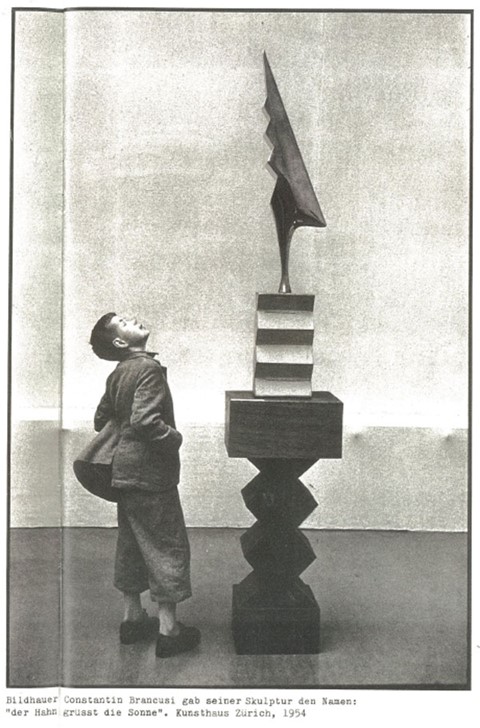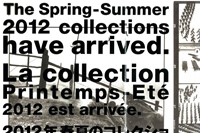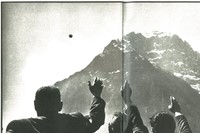Earlier this year, René Burri was approached by Rei Kawakubo of Comme des Garçons to collaborate on a project, where he would allow for his images to be re-appropriated for the brand's printed announcements and invitations.
"It all began because Rei Kawakubo found me. She has an incredible sense of going beyond. When she sent me the first designs, I was amazed because she owned all of my old books. Even the ones from the 1960s, that I did on Germany. She took my work, respected the images and made them into collages in a very interesting way. It is almost like recycling. Taking the same ingredients, but making a new combination, whilst keeping the spirit of things. I was so impressed. In a way, it took my own work further from what I had done at the time, because all I was really doing was going on and on. I couldn't stop. I am the first photographer in the Comme des Garçons series. When her and Adrian Joffe first asked me to be involved, they showed me the work of Ai Weiwei. I remember turning to Rei and saying "but what can I do, how can i do it?". She told me that I didn't have to do anything. That she would take my work, recycle the images and design them. I just saw the last one in the series, no. 29. Rei is really unbelievable. Now, here I am, confronted with a construction of my own work. Looking back, I didn't have the patience to work in fashion. I like women so much, but I was never qualified to torture them in photo shoots. You have to be really tough and brutal. I was also politically motivated, so I was very interested in those things. This interest led me to many stupid moments, like being shot at in a helicopter in Vietnam. I think it was my Swiss curiosity, to poke my nose into this world and into these events. Things that I shouldn't have done. I was lucky and most of the time, I came out unhurt. Most of the time staying cool helped me, but at the end of the day it came down to luck. Pure luck. Even my photography is the result of being there at the right moment.
"Looking back, I didn't have the patience to work in fashion. I like women so much, but I was never qualified to torture them in photo shoots. You have to be really tough and brutal."
It took me six years to get close to Picasso. I learnt a lot from him and he was an absolute genius. He almost became my grandfather at the time. It was like he was a magician or something. He taught me that photography is not just taking pictures, it is how you approach an image. What you do and what you don't do. Unwittingly he inspired me to go beyond what you think is there in front of you. For me he is the ultimate man. He once said "it took me all my life to draw like a child" and I still feel like that. It has taken me all my life just to take a good picture. When I first started working as a photo journalist for Magnum, they said I wouldn't make it, but it was a great couple of decades. I met some fantastic people. Magnum, was in that sense an anarchistic democracy. I grew up in Switzerland, in this kind of rigidity. It was protestant and I was rather shy. That influenced me a lot. When I went to university, the director was from the Bauhaus and my teacher in photography had studied architecture. It was very tough at that time. When I see my early pictures it almost gives me stomach pains. It was so very rigid. I was taught that you had to make a picture so clear that people know what you are saying. That held me for a long time. When you get out there, the world takes you over. When I look back at the early pictures, I am amazed because I was somewhere where so many things were happening and I would just take one picture, make a correction and then that was it. Rather than take lots of them. Then I let the editors of the magazines make their choice. So that training helped from the beginning. The economic situations also made you go for the essential things. Out there you had to fight, when you came back you had to fight. It was a very intense process. Sometimes you lost with the editors, sometimes I felt there was no way of winning, but you had to keep this fighting spirit."
In 1955, when Swiss photographer René Burri became a freelancer for Magnum, he helped to redefine photojournalism. He began documenting major historical, political and cultural events, offering a alternative to official records and capturing intimate portraits of key figures including Che Guevara, Picasso and Le Corbusier. "I think it was my Swiss curiosity, to poke my nose into this world and into these events," he explains, as he sits in the IDEA book space of Dover Street Market, surrounded by his own images. Earlier this year, René was approached by Rei Kawakubo of Comme des Garçons to collaborate on a project, where he would allow for his images to be re-appropriated for the brand's printed announcements and invitations. The result is a hypnotic accumulation of images, in which original photographs are collaged and layered to produce a new vision of his historic works. To coincide with last week's Frieze Art Fair, Dover Street Market have created an large-scale installation of René photographs, reworked by Rei Kawakubo in their window. During the launch, AnOther caught up with René to discuss his prolific career and his collaboration with Comme des Garçons.
Comme des Garçons have produced a limited run of three CDG T-shirts designed by René Burri, available at Dover Street Market, whilst a selection of his books, both old and new, are available in the IDEA Book space.
Text by Isabella Burley



